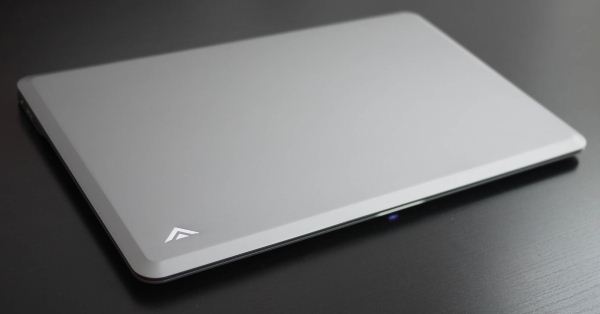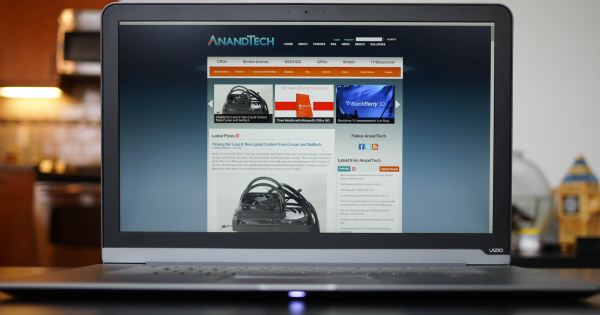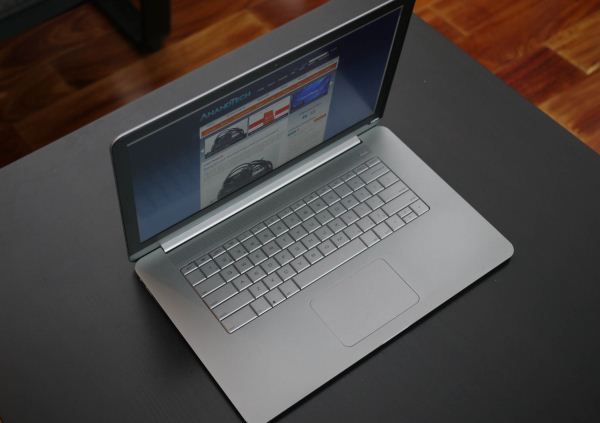Vizio Thin+Light CT15: Something New and Edgy
by Vivek Gowri on February 14, 2013 9:00 AM EST- Posted in
- Laptops
- Intel
- IPS
- Ivy Bridge
- Vizio
- Ultraportable
- Ultrabook
The Vizio is clean and sleek, really a notebook that looks like it was designed by actual industrial designers. This should be a pretty foregone conclusion, but there’s a large number of notebooks out there that don’t look like designers had any say in the designs, especially at the lower end.
The aesthetic is crisp and the entire notebook is very unadorned. There’s nothing glossy on this notebook—not the display, bezel, nor any of the aluminum or the soft touch plastic pieces that make up the chassis. It’s fantastic and I love it.
The body is a single piece of anodized aluminum with a gunmetal finish and the bottom half of the casing is soft-touch plastic. The lid is almost entirely clean, with a small Vizio logo in the top left corner. In profile, the notebook is mostly flat, with tapers at the front and side edges to enhance the perception of thinness. It’s a neat design trick, but I feel like it’s starting to be overused in the world of thin (and not so thin) notebooks. The sides have small portions that are flat, in order to house the meager assortment of ports. The flat part continues across the back of the notebook where the hinge is.
The bezel around the display is perfect—dark plastic with a matte finish, relatively thin, webcam and mics centered above the display, thin aluminum band at the bottom, and a very small Vizio logo at the bottom left corner. Whoever designed it could teach a course on notebook interior design that a lot of other notebook manufacturers could really benefit from.
I’m a fan of where Vizio has gone with their industrial design language, though there’s some refinement that remains on the build quality side of things—the anodization is noticeably coarser than what you find on recent Apple or ASUS devices, while the edges are sharper and more abrupt than they should be. I’ve seen variable build quality between units, with greater degrees of variance in the panel gaps and fit of the keyboard and touchpad. They’re glitches for sure, all signs that point to Vizio being very new to the PC hardware game still, but these are all relatively minor details that they should pick up on and fix as they move forward
Being only 0.68” thick and weighing less than 4 pounds, the CT15 is still slightly bulkier than the smaller and more svelte S9 15” (0.58”, 3.63lbs). Something about the ultrathin 15” form factor, like the Vizio and Samsung, as well as things like the Retina MacBook Pro 15” and the ASUS Zenbook U500, is very aesthetically appealing even though they lack the out-and-out portability of machines with smaller footprints. Even with the superlight weights in play here, the increased size makes this class of system more difficult to use in cramped spaces (such as a plane or lecture hall desk). But damn if they don’t look fantastic.
There’s one huge flaw in this entire design that I’ve been rhapsodizing about though. Surprisingly, it’s not the touchpad—the Sentelic pad that plagued the first run of Windows 7-based Vizio systems has been chucked in favor of a Synaptics unit that’s an absolute breath of fresh air in comparison. Nobody was lying to you, the Sentelic pad actually made the CT15 downright unusable, especially in comparison with the increasingly stellar Elan and Synaptics pads. Sure, they aren’t Apple, but they’re close. The Sentelic was closer to the dark ages for PC touchpads and the series of misguided buttonless pads used by HP and Dell. (Interestingly, my last experience with Sentelic was with the Dell Inspiron 11z from the CULV days. It had a similarly awful touchpad.) But that’s history, and thankfully we have Synaptics and their multitouch gesture suite.
No, the real issue here is the keyboard as well as the metal surrounding it. The keyboard was a problem spot before, too, and hasn’t been fixed. It’s one of the few notebooks that I’ve seen in the last four or five years without a chiclet style keyboard. Even the ThinkPad line, that bastion of old-school notebook design, has moved into the modern world, so it was a bit odd to see the older style of keyboard on this. But I have no quarrel with the keyboard style; the flatness seemed to go well with the rest of the industrial design. Unfortunately, there’s way too much flex involved, and not just in the keyboard itself. The interior aluminum flexes heavily as well, which is odd and indicates a very thin chassis material used. The display also exhibits a bit more flex than I would like, though it’s not a day to day issue like the keyboard and interior is. It’s pretty bad, and a major oversight for a company that seemed to be so detail oriented with the rest of the design.
The upcoming Thin+Light looks basically the same as the current one, but goes a long way towards fixing the interior flex. They made the interior aluminum panel a bit thicker, paired with a stiffer keyboard, and made all the build quality related issues go away. The typing experience is significantly better, though I still think they should move to a chiclet keyboard. You do get used to the flex in the current-gen CT15; it’s not a dealbreaker like the touchpad was previously, but it definitely does detract somewhat from the user experience.














55 Comments
View All Comments
tipoo - Thursday, February 14, 2013 - link
More cache too I believe.Death666Angel - Friday, February 15, 2013 - link
3MB on i5 vs 4MB on i7, yes.xaml - Saturday, February 16, 2013 - link
In a Freudian slip of sorts, Dell put an i5 sticker on my XPS 14 (2012) powered by an i7.StephaneP - Thursday, February 14, 2013 - link
It's all in the subject. I'm surprised that these informations are not in this review.tipoo - Thursday, February 14, 2013 - link
With the Windows 8 multitouch driver, I have zero problems with the touchpad on my 3 year old Dell Studio 15, actually it's pretty good. It's not Mac good, but I'd say something like 80% as good which is good enough for me. The bad input rejection is just right, there is smooth scrolling throughout the OS, good pinch to zoom, etc etc.So would all Vizios you could order now have a Synaptics pad instead of the horrid old one? How can we make sure?
VivekGowri - Thursday, February 14, 2013 - link
All of the Windows 7 ones came with Sentelic touchpads (CT15-A0, A1, A2), while the Windows 8 ones have Synaptics touchpads (A4, A5). A small, but very important, hardware update that came at the same time as the Windows 8 refresh.tipoo - Thursday, February 14, 2013 - link
Awesome, thanks.PEJUman - Thursday, February 14, 2013 - link
I have the following systems: 48GB in x58 970, 16GB on H77 3770, 8GB on P45 Q9650, 8GB on Hudson (AMD C-60) and 4GB on QM77 3217 @ Acer W700. the only way I can use more than 4GB on serious use is by disabling PF. (It is disabled on the 8GB+ systems). the 48GB system is actually used for Ramdrives and VMs. I cannot tell the difference between responsiveness under load (simultaneous encodes/virus scans + browsing/word/excel/ppt/matlab) across these devices; with the exception of the C-60, and that thing got 8GB.To the ultrabook point, I found 4GB is sufficient for occasional power use (even encoding/rippings via DBpowerAmp, quicksync or handbrake). I think the 4GB + SSD IOPs for PF is a good combo and I can't think of any usage pattern that would need more, esp. when the CPU speeds and/or cores counts less than 4. I actually rather take the $20 discount on price than additional 4GB for my mobile devices, they simply become obsolete way too fast nowdays to held any kind of monetary value. I much rather get them cheap & offload them quickly when I upgrade the next year.
My mobile devices are mostly throttled (thermally) on loads that can use 4GB+. so I think present ultrabook thermal constraints is the weakest link in their performance, not RAM or PF speeds.
Huge database on excel, CADs or matlab might cross the 4GB line, but for those you'll probably will be working on a 1600p or multiple 1080p screens (AKA desktop) anyway.
Netscorer - Thursday, February 14, 2013 - link
I owned briefly their first-gen Thin+Light that was available in October for $600 (talk about value!). same form factor, just slightly downspecced with core i5 and 14" 1600x900 display. Loved form factor! Best ultrabook design right after leaders in ASUS and Apple. The three biggest complaints from the users for that generation were (in order)- keyboard
- battery life
- lack of ports.
When I read this review it's like deja vu all over again. Same lackluster keyboard, same disappointing battery life and again no ports beyond bare minimum. Now, if these factors are not critical to you, I would recommend this laptop heartily. It's very sharp looking, has great IPS display and specs that would satisfy all but gamers and developers.
VivekGowri - Thursday, February 14, 2013 - link
No, the absolute number one worst thing about the first-gen system was the touchpad, without question. And I mean, this is the same laptop, just with Windows 8 and a new Synaptics touchpad.Keyboard and battery are getting fixed with the touchscreen ones, and you can cry about lack of ports all day long but on an ultrabook you're just not going to get any semblance of decent port selection. The only thing I feel like could be a reasonably expected addition is an SD card slot. Just be happy it has a full-size HDMI instead of this smartphone-grade micro HDMI stuff that ASUS is using on the Zenbook Prime.